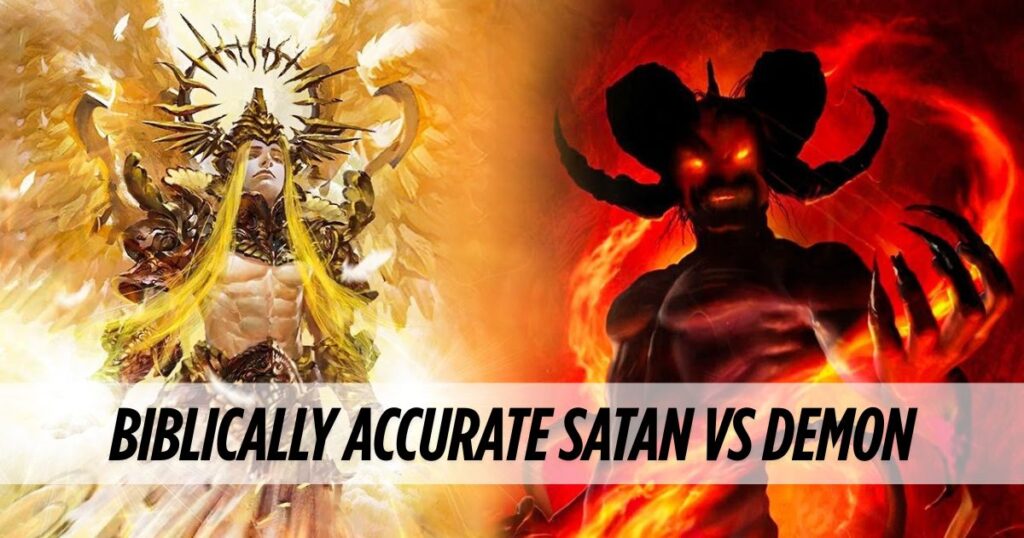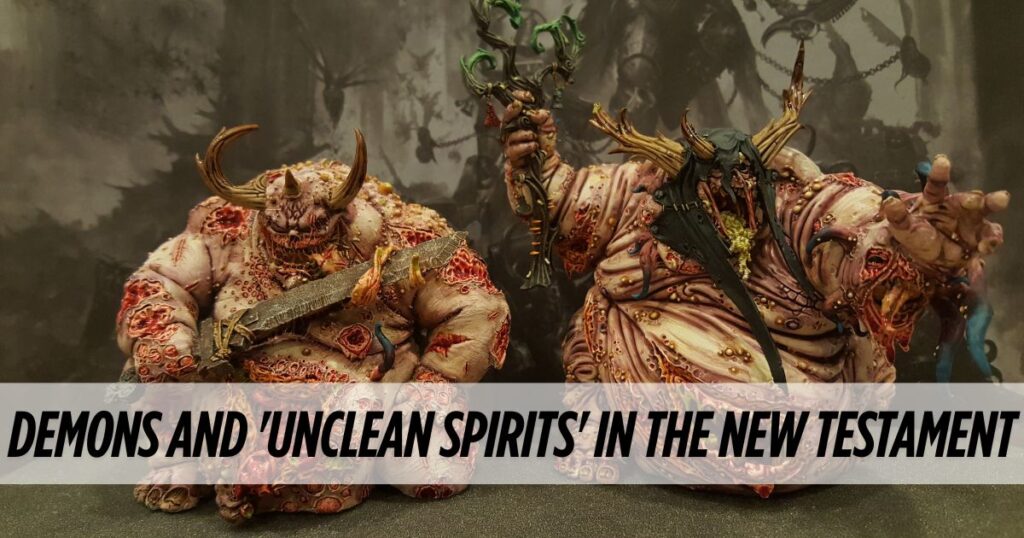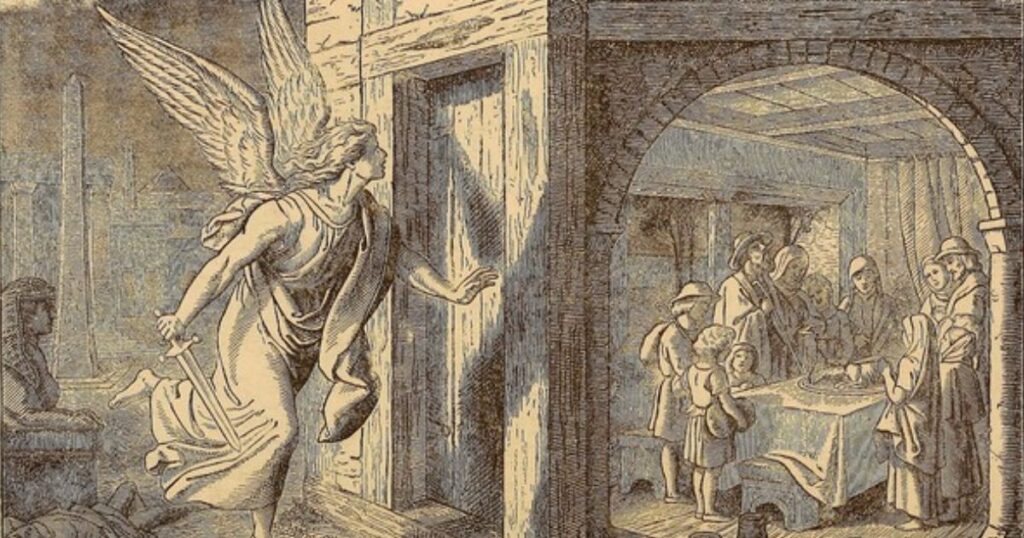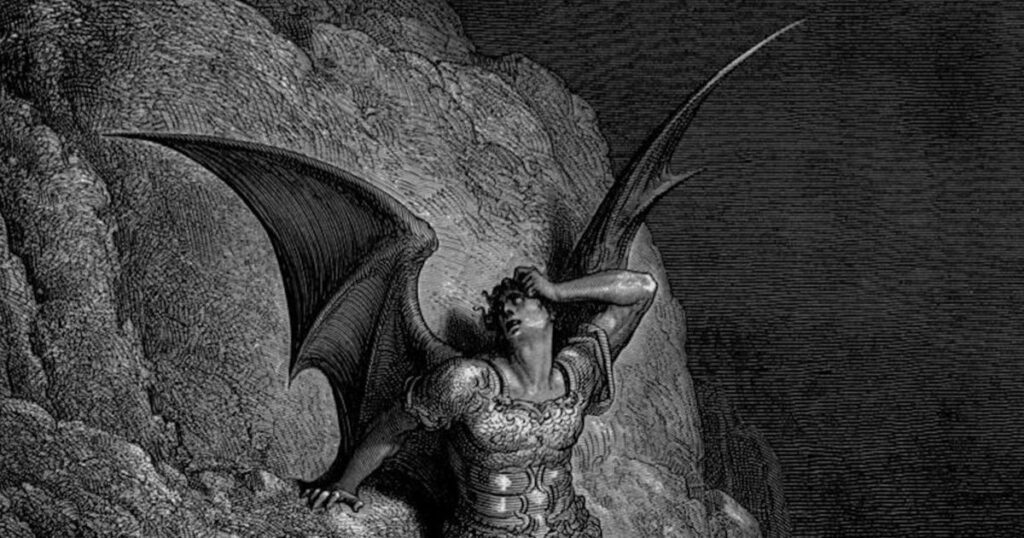Ever wondered what demons really look like according to Scripture? Hollywood’s red-horned villains don’t match the biblically accurate demons described in the Bible. These spiritual beings are far more complex and fascinating than popular culture suggests.
The Bible demons mentioned throughout scriptural references paint a picture that’s both terrifying and educational. Understanding biblical accuracy helps us separate fact from fiction when it comes to these supernatural beings. This comprehensive guide explores what Scripture actually teaches about demonic beings and their true nature.
From Old Testament demonology to New Testament demons, we’ll examine the Hebrew terminology and Greek New Testament descriptions. You’ll discover how Christian theology has interpreted these evil spirits throughout history. This journey through biblical perspectives will strengthen your understanding of spiritual warfare and God’s authority over all creation.
What is Demonology?
Demonology represents the theological study of demons and their activities within Christian doctrine. The term originates from the Greek word “daimon,” which initially described any divine or spiritual beings rather than exclusively evil entities. Christian theology transformed this concept, making clear distinctions between good and evil supernatural beings.
Biblical demonology developed through careful examination of scriptural references and extrabiblical sources. Early church fathers combined Bible teachings with historical accounts to form comprehensive theological perspectives. This spiritual research helped establish the foundations of modern Christian beliefs about demonic influence.
The practice of spiritual discernment became essential for identifying evil spirits versus godly messengers. Ancient believers developed sophisticated methods called “discretio spirituum” to test spiritual beings. This biblical discernment protected communities from demonic possession and false teachings that could lead people astray.
4 Types of Demons
Theological study has identified four primary theories about the origins of biblically accurate demons. Each theory offers different explanations for how these evil spirits came to oppose God’s authority. Understanding these perspectives helps us grasp the complexity of biblical mythology and spiritual warfare.
1. Fallen Angels Theory
Most conservative scholars believe biblical demons are fallen angels who rebelled against God. Matthew 25:41 describes “eternal fire prepared for the devil and his angels,” suggesting angelic rebellion resulted in punishment. Revelation 12:4 indicates Satan took one-third of heaven’s angels with him during his fall from the divine realm.
2. Spirits of the Dead Theory
Some ancient Greek philosophers proposed that demons portrayal involves spirits of wicked deceased humans. This theory appears in popular occult literature but contradicts Bible teachings about the afterlife. Scriptural references clearly state that the wicked dead go to Hades and remain there until final judgment.
3. Pre-Adamic Spirits Theory
The “gap theory” suggests supernatural beings existed before Adam and Eve’s creation. This explanation attempts to reconcile millions of years of Earth’s history with biblical texts. However, most theological perspectives find insufficient scriptural evidence to support this interpretation of demonic beings.
4. Children of Angels Theory
Genesis 6:4 describes “sons of God” who married human women, producing giants called Nephilim. Some interpret this as angelic beings producing offspring with humans. While intriguing, biblical accuracy doesn’t clearly establish that these unions created demons in scripture.
A List of Demons According to the Bible
Biblical demons appear throughout sacred texts with specific names and characteristics. These evil spirits demonstrate varying levels of power and influence over human affairs. Understanding their scriptural precision helps us recognize spiritual warfare patterns in our own lives.
Satan serves as the primary adversary, appearing in Job 1:6-12 and Matthew 4:1-11 as the ultimate opponent of God’s authority. Beelzebub represents the “prince of demons” in Matthew 12:24 and Mark 3:22, often called the “Lord of the Flies.” Lucifer appears in Isaiah 14:12-15 as the “light-bringer” who fell from heavenly glory.
Abaddon/Apollyon guards the bottomless pit in Revelation 9:11, commanding destructive power over end-times events. Legion represents multitude of demons possessing one man in Mark 5:9 and Luke 8:30, demonstrating how demonic influence can overwhelm individuals completely.
Demonology: A Brief Biblical and Historical Background
Christian demonology evolved gradually through centuries of biblical study and theological exploration. Early church fathers carefully examined scriptural references to understand spiritual beings and their roles in divine warfare. This religious study combined canonical Bible teachings with historical references from ancient manuscripts.
Biblical perspectives on demon portrayal developed as scholars compared Hebrew scriptures with Greek scriptures and apostolic writings. The theological study revealed how Jewish teachings influenced early Christian doctrine about evil spirits. This spiritual research helped establish consistent Christian beliefs about demonic beings and their opposition to God’s control.
Extrabiblical sources like the Book of Enoch provided additional context for understanding angelic hierarchies and fallen angels. These non-canonical texts influenced Christian theology without contradicting scriptural accuracy. Biblical scholars used these external documents to fill gaps in biblical narratives about supernatural beings.
Terms for ‘Demons’ in the Bible
Hebrew terminology lacks a single word equivalent to our modern “demon” concept. Ancient language used various terms like “shedim,” “elohim,” and “se’irim” to describe different spiritual beings. This biblical Hebrew complexity explains why Old Testament demons appear more varied and mysterious than New Testament counterparts.
Greek New Testament consistently uses “daimon” to describe evil spirits throughout apostolic writings. This Hellenistic texts terminology provided clearer definitions for early Christian communities. The sacred Greek literature helped standardize Christian beliefs about demonic possession and spiritual warfare.
Translation challenges arise when converting ancient Hebrew concepts into modern languages. Biblical accuracy requires understanding cultural contexts behind Hebrew scriptures and Greek scriptures. This theological perspective helps us appreciate the complexity of scriptural precision in describing supernatural beings.
Ambiguous Purpose
Biblical mythology presents spiritual beings with unclear relationships to God’s authority and each other. Some evil spirits appear to operate independently, while others serve Satan’s influence directly. This scriptural ambiguity has puzzled theological study for centuries, leaving many questions about demonic hierarchy unanswered.
Spiritual discernment becomes challenging when biblical texts show demons in scripture sometimes serving divine purposes. Job’s account reveals Satan requesting permission before testing faithful believers. This biblical perspective suggests God’s control extends even over evil entities and their destructive power.
Christian theology continues debating whether all demonic beings answer to Satan or maintain independent operations. Biblical accuracy doesn’t clearly establish command structures within spiritual warfare. This theological exploration reminds us that divine mysteries surpass human understanding of supernatural forces.
What Does The Devil Look Like?
Satan’s appearance has evolved dramatically throughout art history, influenced by cultural interpretations rather than scriptural accuracy. Biblical texts provide limited physical descriptions of the adversary, focusing instead on his spiritual nature and destructive power. Understanding this demons portrayal helps separate biblical accuracy from popular misconceptions.
Ancient Hebrew texts associate Satan with the serpent in Genesis, though Hebrew scriptures don’t explicitly identify the Eden tempter as Satan. Early Christian interpretations connected these scriptural references based on Revelation 12:9 describing “that ancient serpent.” This biblical perspective established the serpent symbolism that influences Satan’s imagery today.
Medieval artists depicted Satan as a fallen angel with blue, ethereal qualities before transitioning to more bestial representations. Dante’s “Inferno” popularized bat-winged devils that combined Christian theology with ancient mythology. Modern theatrical productions created the red-suited demon image that dominates popular culture but lacks scriptural foundation.
Get Closer to God Today
Spiritual warfare reality should drive believers toward deeper relationship with God rather than fearful obsession with evil spirits. Biblical accuracy emphasizes God’s authority over all supernatural beings and demonic influence. This scriptural truth provides divine protection through faith and prayer.
Christian believers can strengthen their spiritual discernment by studying Bible teachings about God’s power over demonic beings. Daily prayer and Scripture meditation build spiritual armor against evil influences. This biblical approach focuses on God’s control rather than Satan’s power.
Practical steps for spiritual protection include regular Bible study, fellowship with believers, and prayer warriors who understand spiritual warfare. Christian doctrine teaches that Jesus Christ has already defeated Satan and his fallen angels. This biblical truth empowers believers to resist demonic influence through divine strength.
Biblically Accurate Satan vs Demon

Biblical demons and Satan represent distinct categories of spiritual beings with different roles in spiritual warfare. Satan appears as a singular, personal entity who leads demonic forces against God’s authority. Demons in scripture function as plural beings who primarily cause demonic possession and spiritual corruption.
Theological perspectives distinguish between Satan’s unique position as the adversary and demons’ collective activities as unclean spirits. Biblical accuracy shows Satan operating at cosmic levels while demons focus on individual human affliction. This scriptural distinction helps Christian theology understand spiritual hierarchies and divine warfare.
Christian beliefs about Satan evolved from Hebrew terminology meaning “adversary” to Greek New Testament concepts of personal evil. Biblical demons maintained more consistent scriptural portrayal as malevolent spirits throughout sacred texts. Understanding these theological differences strengthens biblical discernment and spiritual warfare preparation.
1. Satan: The Adversary and Accuser
Hebrew terminology “śāṭān” literally means “adversary” or “accuser” in ancient language. Old Testament passages like Job 1-2 and Zechariah 3 present Satan as divine court prosecutor rather than God’s enemy. This biblical perspective shows Satan testing human faithfulness with divine permission.
New Testament writings transformed Satan into personal opponent of God’s authority and Christian believers. Jesus Christ encountered Satan as tempter in Matthew 4:1-11, establishing spiritual warfare patterns. Apostolic writings describe Satan as “father of lies” and “god of this world” who blinds unbelievers.
Biblical accuracy reveals Satan’s evolution from court official to cosmic adversary throughout scriptural history. Greek New Testament terminology “diabolos” emphasizes Satan’s role as accuser and slanderer. This theological development reflects progressive revelation about spiritual warfare and divine justice.
2. Demons: Unclean Spirits, Fallen Angels?
Biblical demons appear as plural entities focused on demonic possession and spiritual corruption of individuals. New Testament accounts describe unclean spirits causing physical ailments and moral degradation. These evil spirits operate differently from Satan’s cosmic opposition to God’s kingdom.
Jesus Christ spent considerable ministry time casting out demons from possessed individuals. Gospel accounts in Matthew, Mark, and Luke detail numerous exorcisms demonstrating divine authority over demonic forces. Apostolic writings granted Christian believers spiritual power to resist demonic influence.
Theological study debates whether biblical demons represent fallen angels, disembodied spirits, or separate spiritual creatures. Church fathers often connected demons to Nephilim spirits from Genesis 6:1-4. Biblical accuracy doesn’t clearly establish demonic origins, leaving this theological question open for continued study.
Satan, Prince of Demons
Satan holds supreme authority over demonic forces as prince of demons and ruler of evil spirits. Biblical texts establish Satan’s leadership through various scriptural references and theological perspectives. This spiritual hierarchy demonstrates organized opposition to God’s authority and Christian believers.
Biblical accuracy shows Satan coordinating demonic activities against divine purposes throughout scriptural history. Spiritual warfare involves Satan’s strategies using fallen angels and unclean spirits to deceive humanity. Christian theology recognizes Satan’s intelligence and supernatural power while maintaining God’s ultimate control.
Theological study reveals Satan’s multiple names and titles reflecting different aspects of his character and demonic influence. Biblical demons operate under Satan’s authority but maintain individual personalities and specific functions. This spiritual organization requires Christian discernment and biblical wisdom to understand enemy tactics.
The Adversary/Accuser
Hebrew scriptures use “satan” as common noun meaning “adversary” in early biblical texts. Old Testament passages like 1 Samuel 29:4 and 1 Kings 11:14 describe human adversaries using this ancient language. Biblical development gradually transformed generic term into proper name for spiritual enemy.
Job’s account presents Satan as divine court member who accuses humans before God’s throne. This biblical perspective shows Satan fulfilling prosecutorial role within heavenly justice system. Zechariah 3:1-2 depicts Satan accusing high priest Joshua before divine judgment.
New Testament writings consistently use Satan as proper name for personal adversary of God and believers. Greek scriptures contain over thirty references to Satan as individual enemy. This theological evolution reflects progressive revelation about spiritual warfare and divine opposition.
The Devil
Greek terminology “diabolos” means “accuser” or “slanderer,” parallel to Hebrew “satan” concept. New Testament writers used both terms interchangeably to describe same spiritual enemy. Biblical accuracy shows consistent portrayal of Satan as deceiver and opponent of divine truth.
Jesus Christ encountered “the devil” during wilderness temptation in Matthew 4 and Luke 4. Gospel accounts establish Satan’s methods of temptation and deception against God’s people. Apostolic writings warn Christian believers about devil’s schemes and spiritual attacks.
Theological perspectives recognize Satan’s titles reflecting his character as father of lies and prince of this world. Biblical demons serve Satan’s purposes but “devil” specifically identifies personal enemy of God’s authority. This scriptural distinction helps Christian theology understand spiritual warfare dynamics.
Other Names Associated With Satan
Biblical texts connect Satan with numerous other entities and titles throughout scriptural history. The Serpent in Genesis 3:1-15 became associated with Satan through Revelation 12:9 reference to “ancient serpent.” Christian theology interprets Eden’s tempter as Satan’s first recorded human deception.
Lucifer appears in Isaiah 14:12 as “light-bringer” who fell from heaven due to pride and rebellion. Early church fathers connected Lucifer’s fall with Satan’s origin story, though biblical accuracy doesn’t explicitly make this theological connection. Christian beliefs about fallen angels often incorporate Lucifer imagery.
Belial represents Hebrew concept of “wickedness” or “worthlessness” that evolved into proper name for evil entity. Beelzebub (“Lord of Flies”) appears as Philistine deity that Jesus identified with Satan’s power. Azazel and Abaddon also became associated with Satan through extrabiblical sources and theological interpretation.
Demons and ‘Unclean Spirits’ in the New Testament

New Testament demons primarily manifest through demonic possession of unwitting humans and occasional animals. Gospel accounts describe malign spirits causing physical ailments, mental afflictions, and immoral behavior. Jesus Christ spent significant ministry time casting out these unclean spirits from suffering individuals.
Biblical accuracy shows demons as invisible entities requiring divine sight to perceive directly. Apostolic writings granted Christian believers spiritual authority to identify and expel demonic influences. Church fathers often connected New Testament demons with Nephilim spirits from Genesis 6:1-4.
Higher-order demons appear in Paul’s letters and Revelation as more powerful entities receiving sacrifices and offering false teachings. Spiritual warfare involves demons promoting alternative worship and doctrinal deception. Christian theology recognizes demonic hierarchy with varying levels of spiritual power and influence.
Demons, Fallen Angels, and Other Semi-Divine Beings in the Old Testament
Old Testament demonology presents more varied and cosmically powerful spiritual beings than New Testament counterparts. Hebrew scriptures describe semi-divine entities with ambiguous purposes and unclear origins. Biblical accuracy reveals ancient Near Eastern influences on Hebrew understanding of supernatural beings.
Fallen angels and demonic beings in Old Testament often appear more frightening and mysterious than later biblical portrayals. Hebrew terminology lacks single word for “demon,” using various terms for different spiritual entities. This linguistic diversity reflects complex theological understanding of spiritual warfare.
Semi-divine beings sometimes appear to serve God’s purposes while maintaining fearsome characteristics. Destroying angels execute divine judgment while chaos monsters represent forces that God controls. Biblical mythology includes entities that challenge human understanding of good versus evil.
Nephilim
Genesis 6:1-4 describes Nephilim as offspring of “sons of God” and human women, creating race of giants. Numbers 13:33 mentions Nephilim as fearsome inhabitants of Promised Land. Biblical accuracy suggests these beings possessed supernatural strength and intimidating presence.
Theological interpretation debates whether “sons of God” refers to angelic beings or descendants of Seth. Book of Enoch identifies Nephilim as children of fallen angels who corrupted humanity. Christian theology often associates Nephilim with demonic influence and spiritual corruption.
Extrabiblical sources describe Nephilim as giants with supernatural abilities and violent tendencies. Jewish teachings connect Nephilim with pre-flood civilization’s moral decay and divine judgment. Biblical perspective presents Nephilim as examples of spiritual rebellion and divine justice.
Shedim and Se’irim
Shedim appear in Deuteronomy 32:17 and Psalm 106:37 as foreign deities demanding child sacrifice. Hebrew terminology describes these entities as winged spirits with serpentine characteristics. Biblical accuracy associates Shedim with pagan worship and abhorrent practices.
Se’irim literally means “hairy ones” or “goat demons” in Hebrew scriptures. Leviticus 17:6-7 warns against sacrificing to these entities. Biblical texts describe Se’irim as goat-legged beings possibly inspiring later Satan imagery.
Ancient Near Eastern parallels connect Se’irim with Greek satyrs and fertility gods. Christian theology interprets these beings as lower-level demons with limited power. Biblical perspective presents Shedim and Se’irim as examples of demonic deception leading God’s people astray.
Lilith
Isaiah 34:14 contains single biblical reference to Lilith, though translation remains disputed. Hebrew text might describe “night creature” rather than specific demonic entity. Biblical accuracy acknowledges uncertainty about Lilith’s scriptural identity and theological significance.
Medieval theology developed extensive mythology around Lilith as “Mother of Demons” and Adam’s first wife. Extrabiblical sources describe Lilith as seductive demon who threatens children and pregnant women. Christian beliefs about Lilith rely heavily on non-canonical texts.
Theological study debates whether biblical reference supports later Lilith traditions or represents poetic language for desolation. Biblical perspective emphasizes scriptural accuracy over popular mythology when understanding spiritual beings. Christian discernment requires separating biblical truth from cultural legends.
Azazel
Leviticus 16:6-10 mentions Azazel in Day of Atonement ritual, though meaning remains disputed. Biblical translations vary between “scapegoat” and proper name for demonic entity. Hebrew terminology creates theological uncertainty about Azazel’s true scriptural identity.
Book of Enoch identifies Azazel as fallen angel who taught humans warfare and cosmetics. Extrabiblical sources describe Azazel’s punishment by archangel Raphael for corrupting humanity. Christian theology often incorporates Enoch’s account while maintaining biblical accuracy.
Early church fathers interpreted Azazel through 1 Enoch traditions rather than Hebrew scriptures alone. Theological perspectives connect Azazel with scapegoat symbolism and sin-bearing concepts. Biblical study requires careful distinction between canonical and extrabiblical sources.
Prince of Persia (and Other ‘Princes’)
Daniel 10 describes supernatural warfare between divine messenger and Prince of Persia. Biblical accuracy reveals 21-day battle requiring archangel Michael’s intervention. Spiritual warfare involves territorial demons opposing God’s messengers and divine purposes.
Theological interpretation suggests spiritual princes govern nations and influence political affairs. Prince of Greece also appears as future opponent in Daniel’s prophecy. Biblical perspective shows cosmic battle between divine and demonic forces over human kingdoms.
Christian theology recognizes spiritual authorities operating behind political powers and cultural influences. Ephesians 6:12 describes principalities and powers as spiritual enemies of Christian believers. Biblical accuracy emphasizes prayer and spiritual warfare against territorial demons.
Mavet (Mot)
Hebrew word “mavet” appears over 100 times in Old Testament meaning “death” but sometimes becomes personified entity. Job 28:22 and Psalm 49:14 present death as conscious being rather than abstract concept. Biblical accuracy suggests poetic language versus literal personification.
Canaanite mythology identifies Mot as god of death and underworld ruler. Hebrew scriptures may reference this deity through personified death imagery. Christian theology debates whether biblical passages describe demonic entity or metaphorical language.
Theological study connects Mavet with Abaddon and Sheol as death-related spiritual concepts. Biblical perspective shows God’s authority over death and underworld powers. Christian beliefs emphasize Christ’s victory over death and demonic forces.
Abaddon
Hebrew word “abaddon” means “destruction” and appears six times in Old Testament as place or entity. Job 28:22 pairs Abaddon with Death as conscious beings. Biblical accuracy suggests personified destruction connected to Sheol and underworld.
Revelation 9:11 identifies Abaddon (Greek: Apollyon) as angel of bottomless pit commanding locust army. New Testament portrays Abaddon as powerful demon with authority over end-times destruction. Christian theology recognizes Abaddon’s apocalyptic significance.
Theological perspectives debate whether Abaddon represents fallen angel, demonic prince, or aspect of Satan himself. Biblical study shows Abaddon’s destructive power under God’s ultimate control. Christian beliefs emphasize divine authority over all spiritual beings.
What do Angels Look Like?
Biblical angels appear dramatically different from popular culture portrayals of winged humans with halos. Scriptural accuracy reveals angels as powerful spiritual beings capable of assuming various forms. Biblical texts describe angels as often frightening divine messengers rather than gentle guardians.
Spiritual beings can manifest in human form so convincingly that people might “entertain angels unawares” according to Hebrews 13:2. Biblical accuracy shows angels appearing as ordinary men in many scriptural accounts. Divine messengers often begin encounters with “fear not” because their presence terrifies humans.
Ezekiel’s vision describes angels as wheels covered with eyes and bizarre creatures with multiple faces. Biblical mythology includes angels with swords engaged in spiritual warfare. Christian theology recognizes angels’ supernatural nature transcends human imagination and artistic representation.
4 Types of Angels
Biblical accuracy identifies four primary angelic categories with distinct characteristics and divine functions. Angelic hierarchies reflect spiritual organization within God’s kingdom. Theological study reveals angels’ specialized roles in divine administration and spiritual warfare.
Cherubim guard sacred places and divine secrets with multiple wings and faces. Genesis 3:24 describes cherubim protecting Tree of Life with flaming swords. Ezekiel’s vision shows cherubim with four faces representing different aspects of creation.
Seraphim surround God’s throne with six wings, continuously praising divine holiness. Isaiah 6 describes seraphim covering faces and feet while flying with remaining wings. Archangels serve as divine messengers and military leaders in spiritual warfare. Guardian angels protect and minister to individual believers.
Destroying Angels: Are They Good or Evil?

Destroying angels operate under God’s direct authority to execute divine judgment despite their fearsome nature. Biblical accuracy shows these beings as divine agents rather than evil entities. 2 Samuel 24 describes destroying angel poised to destroy Jerusalem until God relents.
Spiritual warfare includes God’s angels delivering retribution against divine enemies. 2 Kings 19:35 records angel slaughtering 185,000 Assyrians in single night. Exodus 12:23 mentions “destroyer” killing Egyptian firstborn during Passover judgment.
Theological perspectives recognize destroying angels as morally ambiguous divine instruments. Biblical study shows God’s control over destructive forces for righteous purposes. Christian theology emphasizes divine justice through angelic agents while maintaining God’s ultimate authority.
Pagan Gods Mentioned in the Bible
Biblical texts reference numerous pagan deities worshiped by Israel’s neighbors and sometimes by Israelites themselves. Hebrew scriptures debate whether these gods represent real demonic entities or impotent idols. Christian theology generally interprets pagan gods as either demons or false worship.
Baal appears throughout Old Testament as generic term for “lord” applying to multiple deities. Canaanite religions worshiped various Baals in different regions. Biblical accuracy shows Baal worship leading Israel into idolatry and moral corruption.
Beelzebub (“Lord of Flies”) represents Philistine deity that Jesus identified with Satan’s power. Asherah worship involved wooden poles and fertility rituals. Molech demanded child sacrifice by fire. Biblical perspective presents pagan gods as spiritual dangers opposing true worship.
Chaos Monsters and Dragons
Biblical mythology includes primordial creatures representing forces of chaos and destruction. Near Eastern traditions describe cosmic battles between gods and chaos monsters. Hebrew scriptures show God’s authority over these beings rather than struggling against them.
Leviathan appears in Job 41, Psalm 74:14, and Isaiah 27:1 as mighty sea creature. Behemoth represents powerful land beast in Job 40:15-24. Rahab symbolizes chaos and opposition to divine order in several passages.
Dragons in biblical texts may represent various creatures depending on translation and context. Revelation’s dragon clearly symbolizes Satan and demonic power. Christian theology interprets chaos monsters as either literal creatures or symbolic representations of spiritual forces.
7 Biblically Accurate Demons

Biblical demons demonstrate specific characteristics and behaviors that differentiate them from popular culture portrayals. Scriptural accuracy reveals demons’ true nature as spiritual beings opposing God’s authority. Understanding biblical demons helps Christians recognize spiritual warfare patterns.
Spiritual warfare involves real demonic entities with supernatural power and destructive influence. Biblical accuracy shows demons as intelligent beings capable of strategy and deception. Christian theology emphasizes God’s authority over all demonic forces while acknowledging their dangerous nature.
Theological study of biblical demons strengthens spiritual discernment and faith foundation. These entities represent spiritual realities that Christians must understand for effective spiritual warfare. Biblical perspective balances awareness of demonic influence with confidence in divine protection.
Legion
Legion represents multitude of demons possessing single individual in Mark 5:9 and Luke 8:30. Biblical accuracy shows their collective identity as “we are many” demonstrating overwhelming demonic presence. Jesus Christ cast out entire legion into swine herd showing divine authority.
Gerasene demoniac suffered severe physical and mental torment from Legion’s destructive power. Biblical texts describe supernatural strength and self-destructive behavior caused by multiple demons. Christian theology recognizes severe possession cases requiring divine intervention.
Spiritual warfare lessons from Legion include demons’ ability to coordinate attacks and amplify destructive influence. Biblical perspective emphasizes Jesus’ complete authority over even most severe demonic manifestations. Christian believers can trust divine power against any demonic force.
Abaddon/Apollyon
Found in Revelation 9:11, this figure is described as the angel of the bottomless pit. The Hebrew name “Abaddon” means “destruction,” while the Greek “Apollyon” means “destroyer.” This entity is presented as having authority over locust-like creatures that torment humanity during the end times, representing ultimate spiritual destruction.
The Prince of Persia
Mentioned in Daniel 10:13, this spiritual entity opposed the angel bringing Daniel’s vision for twenty-one days. This passage suggests territorial spiritual warfare, with demonic forces having influence over specific regions or nations. The text indicates a hierarchy of spiritual beings engaged in cosmic conflict.
The Spirit of Divination
Acts 16:16-18 describes a slave girl possessed by “a spirit of divination” (Python spirit in Greek) who followed Paul and Silas. This demon enabled fortune-telling and brought profit to her masters, illustrating how demonic forces can appear beneficial while ultimately being destructive.
Beelzebub
Referenced multiple times in the New Testament, particularly when the Pharisees accused Jesus of casting out demons by “Beelzebub, the prince of demons.” The name likely derives from the Philistine god Baal-zebub, meaning “lord of the flies,” representing corruption and spiritual contamination.
The Spirit of Fear
While 2 Timothy 1:7 states that God has not given us a spirit of fear, the Bible acknowledges that fear can be a spiritual oppression. This manifests as paralyzing anxiety, terror, and intimidation that prevents people from fulfilling their spiritual calling and trusting in God’s provision.
The Unclean Spirits
Throughout the Gospels, Jesus encounters various “unclean spirits” that cause physical and spiritual affliction. These entities represent moral and spiritual contamination, often manifesting through illness, mental torment, or compulsive behaviors that separate individuals from God and community.
FAQ’s
Who are the two fallen angels?
Harut and Marut are a pair of angels mentioned in the Quran who are often said to have fallen to earth due to their negative remarks on humanity.
What is the biblically accurate description of a demon?
The Bible does not provide a clear physical description of demons. They are spiritual beings, and their appearances are generally associated with fear, oppression, and darkness.
What does a biblically accurate devil look like?
In Ezekiel 28, Satan is described as a beautiful angel of light, a guardian cherubim covered with precious stones.
Did Solomon have 700 wives?
Wives and concubines
According to the biblical account, Solomon had 700 wives and 300 concubines.
Is Asmodeus a fallen angel?
Asmodeus is a Greater Demon, particularly a Prince of Hell and a fallen angel. He is associated with the sin of lust and described as “the worst of demons”. He is also known by the name Ashmedai—a king of the demonic spirits of the Shedim and Djinn—and is the father of the warlock Magnus Bane.
The Takeaway
Understanding biblically accurate demons reveals a profound spiritual reality that extends far beyond Hollywood’s theatrical portrayals. These entities represent genuine spiritual forces engaged in cosmic warfare, yet Scripture consistently emphasizes they operate under God’s ultimate sovereignty, not as equals to divine power.
The biblical account serves a dual purpose: validating the reality of spiritual opposition believers face while demonstrating God’s supreme authority over evil forces. From Legion’s overwhelming presence to the subtle deceptions of divination spirits, every demonic encounter recorded in Scripture ultimately showcases Christ’s complete victory.
What emerges is not a call to fear, but an invitation to spiritual maturity. Recognizing these entities’ tactics – whether territorial influence like the Prince of Persia or paralyzing fear spirits – equips believers with wisdom for spiritual discernment. The consistent biblical pattern shows demons flee when confronted with genuine faith and divine authority.
Perhaps most significantly, these accounts remind us that spiritual warfare centers on our relationship with God. The same Jesus who cast out Legion continues offering protection and victory to believers today. Understanding biblically accurate demons should strengthen rather than frighten faith, providing both awareness of spiritual realities and confidence in divine protection that transcends any demonic influence.

Chima Kalu is an experienced blog site admin with 4 years of expertise managing content and user engagement on inthebiblethe. Based in Nigeria, he ensures smooth website operations, quality content, and an interactive user experience.








